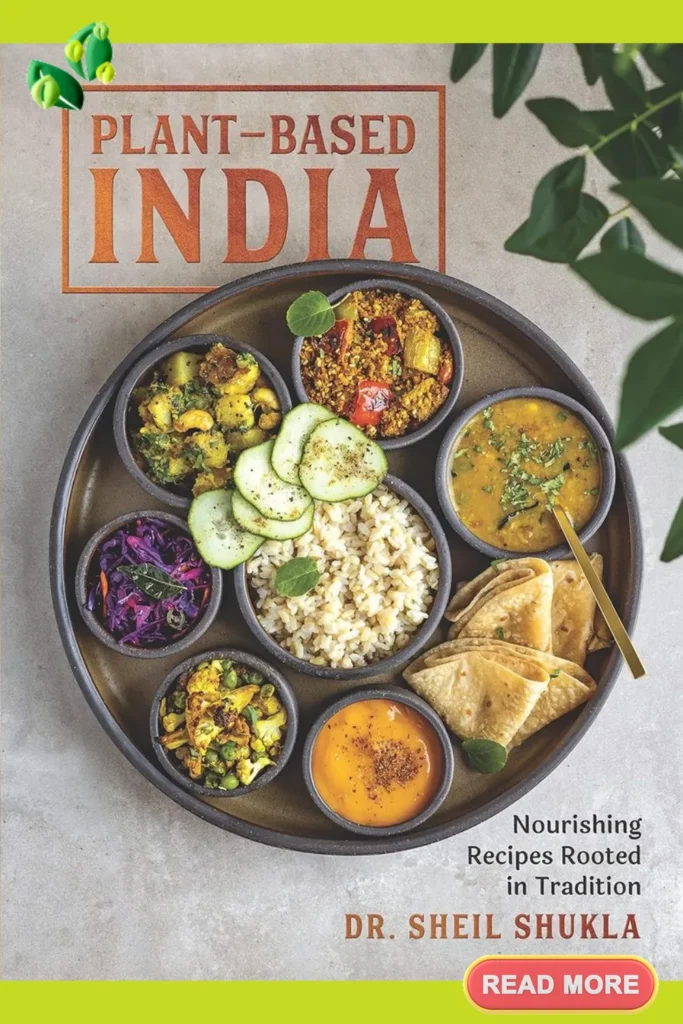Imagine a culinary journey that transports you to bustling Indian markets, where the air is rich with the scent of exotic spices and fresh vegetables.
Envision vibrant colors dancing on your plate, each dish telling a story of tradition and heritage.
Welcome to the world of Indian vegetarian recipes—a treasure trove of flavors that celebrates India’s diverse culture while offering mouth-watering meals devoid of meat.
In a country where nearly 40% of the population practices vegetarianism, these recipes are not just dietary choices but an integral part of daily life.
From savory street food like pani puri to wholesome family meals such as paneer tikka masala, Indian vegetarian cuisine is both diverse and delectable.
Whether you’re a seasoned cook or a novice in the kitchen, this article will guide you through some classic and innovative dishes, providing tips and insights to make your cooking experience truly rewarding.
Indian cuisine is renowned for its rich flavors, vibrant spices, and diverse range of vegetarian dishes.
With a history deeply rooted in traditional Ayurvedic practices, Indian vegetarian recipes are not only delicious but also nutritionally balanced and beneficial for overall health and well-being.
From hearty lentil curries to light and refreshing salads, there is a plethora of options to choose from when exploring the world of Indian vegetarian cooking.
Vegetarianism has long been a central tenet of Indian culture, with many individuals choosing to abstain from meat for religious, ethical, or health reasons.
As a result, Indian cuisine has evolved to encompass a wide array of plant-based ingredients and cooking techniques that showcase the incredible versatility and complexity of vegetarian cooking.
Whether you are a seasoned chef looking to expand your culinary repertoire or a newcomer to the world of vegetarianism, Indian vegetarian recipes offer something for everyone.
In this article, we will explore some of the most popular and beloved Indian vegetarian dishes, as well as provide tips and tricks for mastering the art of Indian vegetarian cooking in your own kitchen.
From classic dishes like chana masala and palak paneer to more modern creations like quinoa biryani and avocado chaat, there is no shortage of delicious and nutritious options to discover.
So, grab your apron and get ready to embark on a culinary journey through the flavors of India’s vegetarian cuisine.
Table of Contents Indian Vegetarian Recipes
Traditional Indian dishes with flair
Indian cuisine is renowned for its diverse array of flavors and spices, enticing food enthusiasts across the globe.
The incorporation of a myriad of aromatic spices, herbs, and rich ingredients gives traditional Indian dishes a unique and vibrant taste.
Each dish carries a distinct richness and complexity, reflecting the culinary heritage and cultural diversity of India.
Whether it is the tantalizing aroma of biryani, the creamy texture of paneer butter masala, or the fiery kick of chana masala, Indian dishes are known for their bold flavors and exotic ingredients.
The artful blending of spices and the meticulous cooking techniques used in Indian cuisine truly elevate these dishes to a level of culinary excellence that is both satisfying and unforgettable.
Spice-rich, nutritious vegetarian delights
Embracing a plant-based lifestyle opens the door to a world of spice-rich, nutritious vegetarian delights that captivate the senses and nourish the body.
Vegetarian cuisine, particularly in the Indian culinary landscape, showcases an exquisite fusion of flavors, textures, and colors that elevate simple ingredients to gourmet heights.
From the creamy comfort of dal makhani to the tangy zest of vegetable biryani, these dishes are not only a feast for the taste buds but also a wholesome source of essential nutrients.
Packed with vibrant spices such as cumin, turmeric, and coriander, these vegetarian creations provide a flavorful journey through the diverse and bountiful realm of Indian culinary traditions.
Whether savoring a hearty bowl of palak paneer or relishing the delicate balance of spices in aloo gobi, each bite offers a symphony of flavors that celebrate the art of vegetarian cooking.
Diverse flavors in veg cuisine
Crafted with a myriad of aromatic ingredients and cooking techniques, vegetarian dishes from around the world offer a tantalizing array of diverse flavors that cater to a wide range of palates.
The fusion of herbs, spices, and exotic produce in vegetable-based cuisines transcends cultural boundaries, enriching culinary experiences with a medley of tastes and textures.
From the fiery kick of Mexican salsa verde to the umami richness of Japanese miso soup, vegetarian recipes showcase the versatility and creativity that can be achieved without relying on meat-based ingredients.
Embracing this global tapestry of flavors allows for a diverse and fulfilling gastronomic journey that celebrates the richness and complexity of vegetarian cuisine.
Simple recipes for everyday cooking
Requiring no extensive culinary expertise or elaborate preparation, simple recipes for everyday cooking offer a practical and convenient way to create delicious meals that can easily fit into a busy schedule.
These recipes typically utilize basic ingredients that are readily available in most kitchens, allowing for quick and effortless meal preparation without compromising on flavor or nutrition.
With a focus on simplicity and efficiency, everyday recipes streamline the cooking process, making it accessible to individuals at any skill level.
By incorporating straightforward techniques and minimal cooking time, these recipes enable individuals to enjoy wholesome and satisfying meals on a regular basis, promoting a healthy and balanced lifestyle.
Balancing health and taste
Achieving a harmonious balance between health and taste is essential in culinary practices, particularly when crafting nutritious yet flavorful dishes.
By incorporating a variety of fresh herbs, spices, and seasonings, individuals can enhance the taste profile of dishes without compromising on nutritional value.
Additionally, opting for cooking methods that retain the natural goodness of ingredients while infusing them with delicious flavors can elevate the overall dining experience.
Balancing health and taste involves a mindful selection of ingredients that not only provide essential nutrients but also contribute to the rich and satisfying taste of the final dish, catering to both the palate and well-being of individuals.
Exploring regional vegetarian delicacies
Diving into the diverse tapestry of regional vegetarian delicacies unveils a treasure trove of culinary delights that showcase the cultural richness and culinary expertise of various Indian regions.
From the vibrant and aromatic South Indian dishes bursting with flavors of coconut, curry leaves, and tamarind to the hearty North Indian specialties encompassing a melange of spices such as cumin, coriander, and garam masala, each region offers a unique gastronomic experience.
Exploring these regional vegetarian delicacies not only introduces individuals to a plethora of distinctive flavors and ingredients but also provides a glimpse into the culinary heritage and traditions deeply embedded in the diverse Indian culture.
Elevating meals with aromatic spices
Incorporating aromatic spices into your cooking endeavors can significantly elevate the sensory experience of your meals.
A well-balanced blend of spices not only enhances the flavor profile of dishes but also adds depth and complexity to each bite.
Introducing spices such as fragrant cardamom, earthy turmeric, pungent mustard seeds, and warm cinnamon can transform a simple dish into a culinary masterpiece, tantalizing the taste buds with a harmonious symphony of flavors.
By skillfully incorporating these aromatic spices into your culinary creations, you can embark on a flavorful journey that transcends mere sustenance, transforming each meal into a sensorial delight that captivates the palate and celebrates the art of gastronomy.
Culturally rich, veg-centric Indian cooking
Drawing upon a rich tapestry of culinary traditions, Indian cuisine celebrates the vibrant diversity of flavors, textures, and colors that make it a true gastronomic delight.
With a strong emphasis on vegetarian offerings, Indian cooking showcases an array of fresh produce, legumes, and grains that form the cornerstone of hearty and nutritious meals.
From aromatic curries bursting with spices to crispy pakoras and comforting dals, each dish tells a story steeped in tradition and regional influences.
The art of Indian cooking lies not only in the skillful use of spices but also in the meticulous blending of ingredients to create dishes that are not only nourishing but also deeply satisfying to the soul.
Embracing the veg-centric ethos of Indian cuisine opens up a world of possibilities, inviting culinary explorations that are as diverse as the subcontinent itself.
In conclusion, Indian vegetarian cuisine offers a diverse and flavorful array of dishes that cater to a variety of tastes and dietary preferences.
With an emphasis on fresh vegetables, aromatic spices, and wholesome ingredients, these recipes showcase the rich culinary heritage of India.
Whether you are a seasoned chef or a novice in the kitchen, exploring the world of Indian vegetarian cooking can be a rewarding and fulfilling experience.
From comforting lentil stews to vibrant vegetable curries, there is no shortage of delicious and nutritious options to try.
Embrace the vibrant flavors and aromatic spices of Indian vegetarian cuisine, and embark on a culinary journey that will delight your taste buds and nourish your body and soul.
FAQ
What are some popular Indian vegetarian dishes that are easy to make at home?
Some popular Indian vegetarian dishes that are easy to make at home include vegetable biryani, chana masala, palak paneer, aloo gobi, dal tadka, and vegetable korma.
These dishes typically require common ingredients like vegetables, spices, lentils, and rice, making them suitable for home cooking.
With simple recipes readily available online, anyone can easily recreate these flavorful and nutritious Indian dishes in their own kitchens.
How can traditional Indian spices be used to enhance the flavors of vegetarian dishes?
Traditional Indian spices such as cumin, turmeric, coriander, and garam masala can enhance the flavors of vegetarian dishes by providing depth, complexity, and warmth.
Cumin adds a nutty flavor, turmeric adds color and earthiness, coriander adds a citrusy note, and garam masala adds a warm, aromatic touch.
These spices can be used in various combinations to season vegetables, lentils, rice, and legumes, creating rich and flavorful vegetarian dishes that are both satisfying and delicious.
What are some healthy and nutritious ingredients commonly used in Indian vegetarian recipes?
Commonly used healthy and nutritious ingredients in Indian vegetarian recipes include lentils (such as dal), vegetables like spinach, tomatoes, and cauliflower, spices like turmeric, cumin, and ginger, and whole grains like rice and millet.
These ingredients are rich in essential nutrients like protein, fiber, vitamins, and minerals, making them a staple in Indian cuisine for their health benefits.
Incorporating these ingredients into vegetarian dishes not only adds flavor and variety but also ensures a well-rounded and balanced diet.
Are there any regional variations in Indian vegetarian cooking, and if so, what are some examples?
Yes, there are significant regional variations in Indian vegetarian cooking.
For example, in North India, dishes like paneer butter masala and dal makhani are popular, while in South India, dishes like dosa, idli, and sambar are more common.
In the West, dishes like dhokla and thepla are popular, while in the East, dishes like mishti doi and shukto are traditional.
Each region’s cuisine is influenced by factors such as climate, culture, and available ingredients, leading to a wide range of diverse and flavorful vegetarian dishes across India.
How can someone who is new to Indian cooking learn to make delicious vegetarian dishes?
Someone new to Indian cooking can start by researching traditional recipes, watching online tutorials, and practicing basic techniques such as tempering spices, making homemade curry pastes, and cooking lentils and vegetables.
Experimenting with different ingredients and flavors, seeking guidance from experienced cooks, and being open to learning from mistakes are also key in mastering the art of creating delicious vegetarian Indian dishes.
Additionally, investing in essential spices, herbs, and kitchen tools commonly used in Indian cuisine can help elevate the overall cooking experience.

